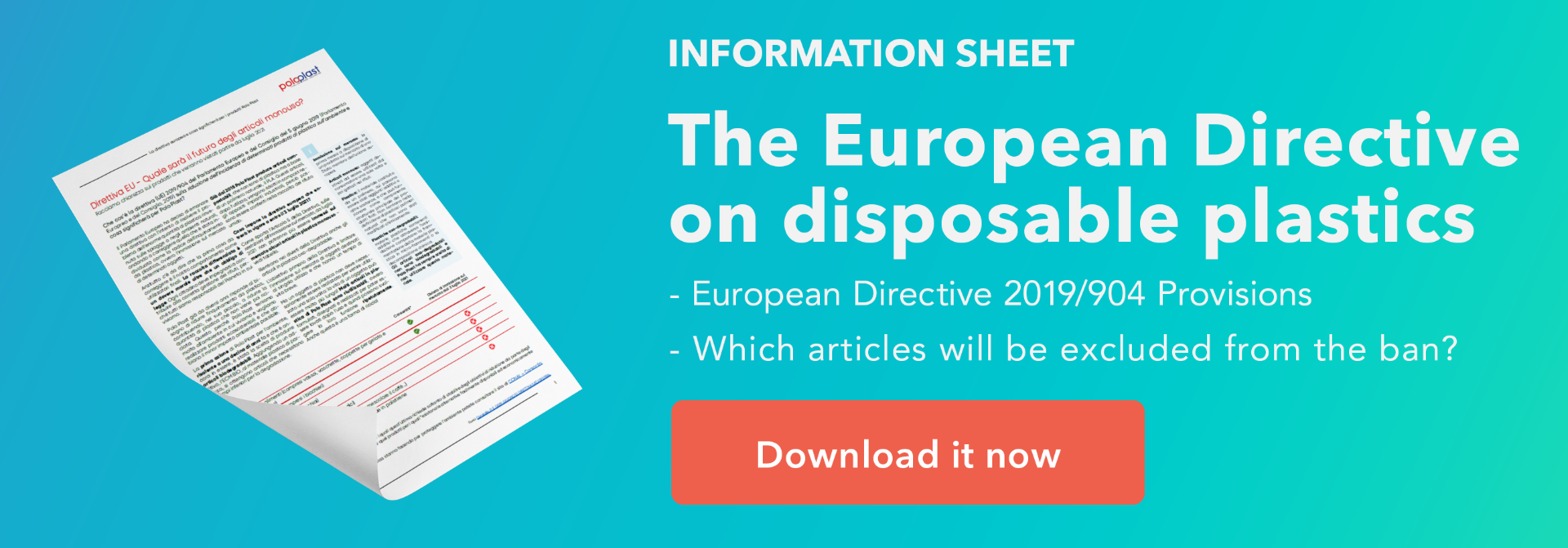European Directive 2021 for single-use plastic products
EU Directive 2019/904
THE FUTURE OF
DISPOSABLE PLASTIC
EU Directive – What will the future of disposable items be?
What is the (EU) Directive 2019/904 of European Parliament and European Council of 5 June 2019 (Europen Parliament and Eurpean Council, 2019) on the reduction of incidence of certain plastic items in the environment and what will this mean for Polo Plast?
The European Parliament has decided to issue a directive with the aim of solving the problem of the huge quantity of plastic discovered on beaches and natural environment, trying to correct the fact identified as being the root of plastic pollution, so the placement in the market of certain objects.
First of all we have to say that plastic is a source. What we should correct is our behaviour as final consumers. Separate collection is so a moral duty as well as forced by law. Every citizen has to commit himself and contribute to the correct waste management, because plastic, if correctly collected could be recycled and re-used to the infinity.
The first action of Polo Plast for the environment, started ten years ago and today still in place, was the choice to produce bio-degradable items. Adding an additive, called ECM BIO to the plastic raw material, we obtain items that need less time to dispose.
Since 2015 Polo Plast produces compostable items, that are not made of plastic but of a raw material called PLA, which is a natural polymer. These articles, after their usage, are transformed in compost in the industrial plants dedicated, so they can be disposed in the organic waste (we advice you to verify the rules of your municipality of residence).
In some countries of the European Union PLA items are currently regarded as plastic, due to the extra process required to be considered in all respects organic waste. In other countries (such as Italy), they are classified differently and therefore they are not subject to the same limitations as plastic.
Marking
From July 2021, the EU Single Use Plastic Directive (SUPD) requires a standard marking ("plastic in product") for a range of packaging items, including paper cups for beverages, which are made partly of plastic. It is mandatory to include this clearly legible and indelible marking regardless of the amount of plastic contained in the product.
- Paper cups sold in European Union countries after July 3rd, 2021 must have the marking
- Until July 4th, 2022, products may present the marking by means of stickers
- Marking must contain the language of the country in which the product is used
- Marking is mandatory on all paper cups containing PE or PLA
The directive also includes plastic cups, which will have to include a specific marking that will be applied in pad printing.
Which limitations does the directive imply?
Article 5 of the Directive, about restriction on market placement, states that certain single-use plastic products that are designed for single use and are easily released in the environment due to their volume and size (for example packaging for straws)will no longer be allowed on the market – download the detailed chart.
The prohibition of the Directive include also items made of oxo-degradable plastic, that Polo Plast does not produce.
Primary objective of the directive is to limit the placement in the market of objects intended for individual use, that have a short lifetime.
But a plastic item is not necessarily made to be used just one time: lifetime of an object can be even longer! Many Polo Plast plastic prodcuts are re-usable, so intended, designed and realized to be washed after usage, so they can perform their function repeatedly. Even this is a way of recycling!
When will the European directive come into force?
The deadline for member states to adapt to the guidelines included in the directive has been set for July 3, 2021, despite this, many countries (including Italy, which has postponed the decision to early October) still have not put into effect the bans related to this directive, postponing any official decision to to a date to be determined.

